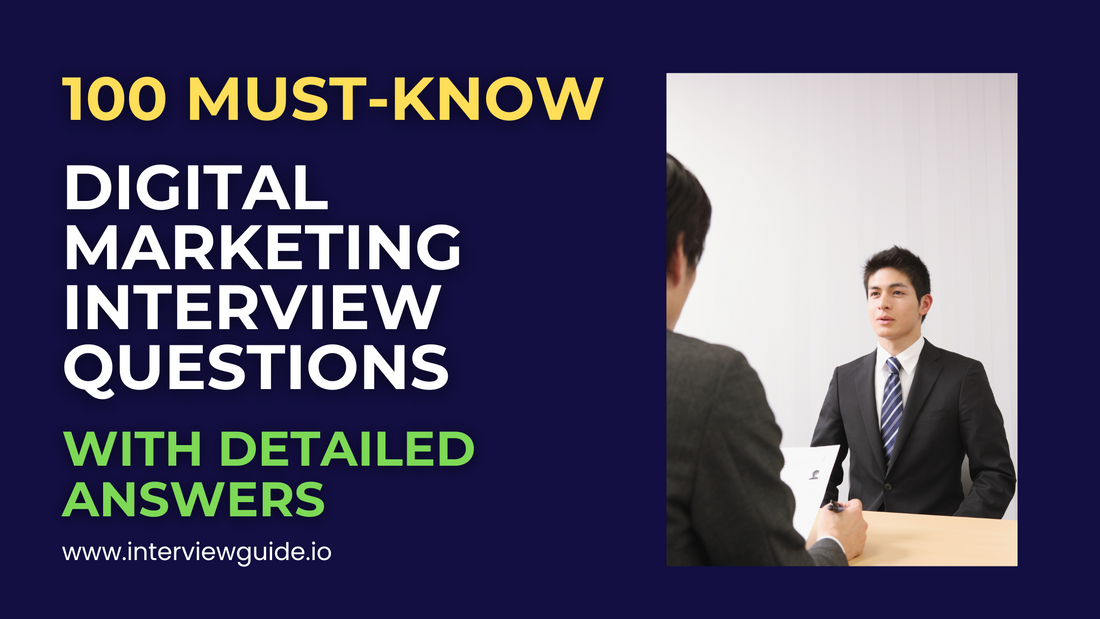
100 Digital Marketing Interview Questions & Answers
Share
Preparing for a Digital Marketing job interview? Whether you’re applying for a role as an SEO specialist, social media manager, content strategist, or digital marketing executive, it’s important to know what to expect and how to present your skills effectively. Employers are looking for candidates who can combine creativity with data-driven strategies, stay up to date with the latest marketing trends, and deliver measurable results across different online channels.
In this article, we’ve compiled 100 of the most common Digital Marketing interview questions, along with sample answers to help you stand out. From SEO and PPC campaigns to analytics, content marketing, and email strategy, this comprehensive guide will prepare you to walk into your interview with confidence and demonstrate your expertise. Let’s get started!
1. What Is Digital Marketing, and How Does It Differ From Traditional Marketing?
Digital marketing refers to the promotion of products or services through digital channels, including websites, social media, email, and search engines. Unlike traditional marketing, which relies on print ads, television, or radio, digital marketing allows for real-time interaction and engagement with consumers. It uses data analytics to target specific audiences more effectively and measure campaign performance accurately. Digital marketing provides the ability to track user behavior, optimize marketing strategies on the fly, and reach a global audience at a fraction of the cost compared to traditional methods. This shift is key in today’s increasingly digital world, as consumers increasingly rely on online platforms for their purchasing decisions.
2. What Are The Key Components Of A Successful Digital Marketing Strategy?
A successful digital marketing strategy includes several key components. First, a clear understanding of the target audience is essential, as it guides all marketing efforts. Second, setting measurable goals allows for tracking progress and adjusting strategies as needed. Third, content creation is vital, focusing on quality and relevance to engage the audience. Fourth, utilizing various digital channels, such as social media, email, and SEO, enhances visibility. Fifth, data analysis plays a crucial role in evaluating performance and refining tactics. Finally, maintaining consistency across all platforms ensures brand integrity and customer trust.
3. How Do You Define A Target Audience?
A target audience is a specific group of consumers identified as the intended recipients of a marketing message or campaign. Defining a target audience involves analyzing various factors such as demographics, psychographics, geographic location, buying behavior, and needs. By understanding these characteristics, marketers can tailor their strategies and messaging to resonate with their audience effectively. This ensures that marketing efforts are not wasted on uninterested consumers, leading to higher engagement and conversion rates. Identifying a target audience allows businesses to create more personalized and relevant campaigns, improving the likelihood of achieving their marketing objectives.
4. What Is The Difference Between Inbound And Outbound Marketing?
Inbound marketing focuses on attracting customers through valuable content and experiences tailored to their needs. This method relies on techniques such as SEO, content marketing, and social media to engage potential clients, guiding them through the buyer's journey until they are ready to make a purchase.
In contrast, outbound marketing involves pushing messages to a broader audience, often through traditional advertising methods like TV commercials, print ads, and cold calling. This approach interrupts the target audience, seeking immediate attention, often resulting in lower engagement rates. The key distinction lies in the customer’s journey: inbound nurtures and builds relationships, while outbound seeks quick conversions through direct outreach.
5. Explain The Customer Journey In Digital Marketing.
The customer journey in digital marketing refers to the process that potential customers go through from the moment they become aware of a product or service until they make a purchase and beyond. It typically consists of several stages: awareness, consideration, and decision. In the awareness stage, customers discover a brand through content, social media, or ads. During consideration, they evaluate options and seek more information. Finally, in the decision stage, they make a purchase. Post-purchase, the journey continues with customer retention and advocacy, where brands engage customers to encourage loyalty and referrals. Understanding this journey helps marketers tailor strategies to meet customer needs at each stage.
6. What Are Buyer Personas, And Why Are They Important?
Buyer personas are semi-fictional representations of your ideal customers, based on market research and real data about existing customers. They help businesses understand their audience's motivations, behaviors, and pain points. By developing detailed personas, companies can tailor their marketing strategies, content, and product offerings to better meet the needs of their target audience. This targeted approach enhances customer engagement, improves conversion rates, and increases customer loyalty. Buyer personas also guide teams in making informed decisions regarding messaging, channels, and tactics, ensuring that marketing efforts resonate more effectively with the intended audience.
7. How Do You Measure Digital Marketing ROI?
Measuring digital marketing ROI involves evaluating the return on investment generated from marketing activities. Start by identifying key performance indicators (KPIs) relevant to your goals, such as sales revenue, lead generation, or website traffic. Use tracking tools like Google Analytics to gather data on conversions and traffic sources. Calculate ROI using the formula: [(Revenue - Cost of Investment) / Cost of Investment \times 100]. This provides a percentage that indicates the effectiveness of your marketing efforts. Regularly analyze these metrics to adjust strategies and optimize future campaigns for better results. Tracking lifetime customer value can also provide insight into long-term ROI.
8. What Are KPIs In Digital Marketing? Give Examples.
Key Performance Indicators (KPIs) in digital marketing are measurable values that demonstrate how effectively a company is achieving key business objectives. They help marketers assess the success of their campaigns and strategies. Common examples of KPIs include website traffic, conversion rates, click-through rates (CTR), return on investment (ROI), and engagement metrics on social media. For instance, tracking the number of leads generated from a specific campaign can indicate its effectiveness. Additionally, monitoring bounce rates can help identify issues with user experience on a website. By analyzing these indicators, marketers can optimize their strategies for better outcomes.
9. What Is The Difference Between B2B And B2C Marketing Strategies?
B2B (Business-to-Business) marketing strategies focus on selling products or services to other businesses. These strategies often emphasize building long-term relationships, showcasing expertise, and providing detailed information to decision-makers. The sales cycle tends to be longer, involving multiple stakeholders and a greater emphasis on rational decision-making.
In contrast, B2C (Business-to-Consumer) marketing strategies target individual consumers. These strategies typically prioritize emotional appeal, brand storytelling, and quick transactions. B2C marketing often uses social media, influencers, and visual content to engage consumers, leading to faster purchasing decisions. Understanding the distinct motivations and behaviors of each audience is essential for effective marketing in both sectors.
10. What Role Does Content Play In Digital Marketing?
Content is fundamental in digital marketing as it serves multiple purposes. It attracts and engages potential customers, providing them with valuable information that addresses their needs and interests. Quality content enhances brand visibility through search engine optimization (SEO), helping businesses rank higher in search results. It also supports customer retention by fostering relationships through informative and entertaining material. Content can be tailored for various platforms, including blogs, social media, and email, ensuring that it reaches the target audience effectively. Ultimately, compelling content builds trust and credibility, driving conversions and brand loyalty.
11. How Do You Perform Competitor Analysis In Digital Marketing?
Competitor analysis in digital marketing involves assessing your rivals' strategies to identify strengths and weaknesses. Start by identifying key competitors and analyzing their online presence, including websites, social media, and content marketing efforts. Utilize tools like SEMrush or Ahrefs to gather data on their SEO performance, keywords, and backlinks. Evaluate their social media engagement and ad campaigns to determine their target audience and messaging. Additionally, assess their customer reviews and feedback to understand market perception. Finally, compile the findings into a report, highlighting opportunities for your brand to differentiate and improve its strategies.
12. What Is The Difference Between Organic And Paid Marketing?
Organic marketing refers to strategies that attract customers naturally over time without paying for advertising, such as SEO, content marketing, and social media engagement. It builds brand loyalty and trust, relying on valuable content to draw in users. Paid marketing, on the other hand, involves spending money on advertisements to reach target audiences quickly, such as pay-per-click (PPC) campaigns or social media ads. This approach delivers immediate results and can be highly targeted, but it requires ongoing investment. Both strategies play vital roles in a comprehensive marketing plan, complementing each other to achieve wider reach and engagement.
13. What Are Some Common Digital Marketing Channels?
Digital marketing channels include a variety of platforms and methods used to reach and engage audiences. Key channels are:
- Search Engines: Utilizing SEO and SEM to increase visibility.
- Social Media: Platforms like Facebook, Instagram, and Twitter for organic and paid engagement.
- Email Marketing: Sending targeted messages to nurture leads and retain customers.
- Content Marketing: Creating valuable content to attract and retain audiences.
- Affiliate Marketing: Collaborating with partners to drive traffic and sales.
- Display Advertising: Visual ads placed on websites to capture attention.
Each channel serves unique purposes and can be integrated for a cohesive marketing strategy.
14. How Do You Stay Updated With The Latest Digital Marketing Trends?
Staying updated with the latest digital marketing trends involves a multi-faceted approach. First, subscribing to industry-leading blogs and websites, such as HubSpot, Moz, or Search Engine Journal, is essential for receiving timely insights. Participating in webinars and online courses can enhance knowledge and keep skills sharp. Engaging with professional networks on platforms like LinkedIn allows for sharing experiences and learning from others. Following influential marketers on social media provides quick updates and diverse perspectives. Lastly, attending industry conferences and workshops promotes networking and exposure to innovative strategies and tools in the ever-evolving digital landscape.
15. What Is Omnichannel Marketing?
Omnichannel marketing is a strategic approach that integrates multiple channels to create a seamless customer experience. It focuses on delivering a consistent brand message across various platforms, such as websites, social media, email, and physical stores. The goal is to ensure that customers can interact with a brand effortlessly, regardless of the channel they choose. By leveraging data analytics, businesses can gain insights into customer behavior and preferences, allowing for personalized marketing efforts. This strategy enhances customer engagement, fosters loyalty, and ultimately drives sales by providing a cohesive journey from awareness to purchase.
Click here to download all 100 questions and answers as a PDF
